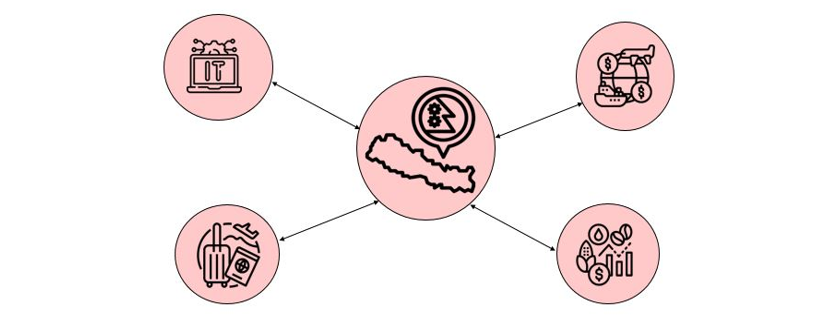Trade development strategies are intended to mitigate trade hurdles, identify growth prospects, and lay out long-term action plans. The International Trade Centre (ITC) offers five tips for successful export-focused trade policy: develop competitive infrastructure, boost exports and foreign investments, improve cross-border trade, tackle export market challenges, and enhance inputs and capital goods. Crafting and executing trade strategy is vital, particularly in Least Developed Countries (LDCs) such as Nepal. These nations face multiple obstacles to fostering trade and sustainable growth, encompassing insufficient trade infrastructure, landlocked geography, low productivity, unstable government, and climate change.
Nepal’s Ministry of Industries, Commerce, and Supplies (MoICS) recently launched the fourth Nepal Trade Integration Strategy (NTIS) 2023 to be implemented for five years starting from 2023 AD (FY 2079/80 BS) to 2028 AD (FY 2074/75 BS). This strategy was developed considering the approaching graduation from LDC status to a middle-income developing country in 2026. A total budget of NPR 46.32 billion (USD 349.62 million) has been estimated to implement NTIS 2023. Furthermore, underlining the government’s commitment, the budget of FY 2023/24 has allocated NPR 40 million (USD 303 thousand) to implement the NTIS 2023.
Figure 1: Nepal and International Trade
Source: Author’s compilation using flat icon
History of Trade Strategies in Nepal
In 2004, Nepal approved its first Diagnostic Trade Integration Studies (DTIS) under the name Nepal Trade and Competitiveness Study (NTCS). After that, Nepal developed the NTIS 2010 with 12 goods and 7 services as priority. Six years later the NTIS 2016 was created and adopted by analyzing and addressing the challenges and lessons learned from previous strategies. Although the NTIS is reviewed every five years, the new NTIS 2023 was developed after a seven-year gap mainly because of political instability and frequent changes in the government.
Key Features of NTIS 2023
Trade Infrastructure Development and Trade Facilitation
NTIS 2023 has a policy to develop a master plan for trade infrastructure construction and improvement. The strategy includes formulating criteria for trade infrastructure growth and improving digital trade through logistics service provider training. The strategy suggests developing IT and physical transportation infrastructure for easier cross-border trade. Similarly, NTIS plans to upgrade and utilize the postal service to support digital trade.
Labor, women’s empowerment, and social cohesion
NTIS 2023 aims to enhance the inclusion of women in the trade labor force and promote social inclusion. In this regard, there is a provision to establish a women empowerment and social inclusion unit inside the NTIS department. The strategy has targeted to carry out research on challenges faced by women in participating in trade and collect gender-disaggregated data. Furthermore, the strategy suggests carrying out awareness, monitoring, and evaluation of women’s participation in the export of priority products and services.
Food and agricultural commodities infrastructure and quality
In terms of food safety and agricultural quality, there have been several suggestions and recommendations related to testing facilities and quarantine centers made in the NTIS. The strategy includes upgrading testing and plant quarantine facilities in Kathmandu and Birgunj. It also involves establishing similar facilities at major border crossings in coordination with provincial governments and neighboring countries.
Use of fourth and fifth industrial revolution
Suggestions in NTIS 2023 underscore the needs and benefits of utilizing the fourth and fifth industrial revolutions to enhance international trade in Nepal. The strategy identifies Business to Business (B2B), Business to Costumer (B2C), Costumer to Costumer (C2C), and Customer to Business (C2B) as appropriate to use digital trade for cost-effectiveness and productivity. The NTIS suggests changes in the Electronic Transaction Act, 2063, formulation of industry 4.0 strategy, and investment for industry 4.0 in every province. The creation of a national payment gateway and a national digital depository for easier digital transactions has also been mentioned.
Export priorities
The new NTIS 2023 has increased the list of promising export products and services to 32 from 12 in the previous NTIS 2016. In NTIS 2023, new additions include lentils, jute, produce, fruits, spices, and coffee, along with handmade paper, rosin, turpentine, aromatic oil, and long fiber textiles. In the large-scale industry category, iron and steel, cement, and ready-made clothing have been added. Small and cottage industries now include jewelry, pasta, Himalayan spring water, honey, dog chew, and felt. Electricity, along with IT and business process outsourcing (BPO), tourism, and skilled and semi-skilled professionals in remittance-generating professions, has been included in services exports. Aside from India, the United States, the European Union, the United Kingdom, and Turkey are identified as the biggest export markets for Nepali goods.
Implementation, monitoring and assessment
NTIS 2023 has included some of the implementation and assessment measures required for the success of the strategy. The strategy proposes additional roles and responsibilities for the multilateral trade and trade facilitation division including facilitation of good and services trade, gathering and analysis of trade market intelligence data, etc. Similarly, the strategy recommends the formation of a National Steering Committee to pass the annual budget, analyze progress, and provide future direction for the plan. Furthermore, NTIS 2023 envisions making the role of development partners, private sectors, and foreign missions of Nepal effective in the implementation of the strategy.
Conclusion and Way Forward
The NTIS 2023 needs to ensure actual increment in export volumes of the targeted export items and services. According to experts, NTIS has not been able to increase exports because of numerous execution hurdles. The meetings of the Board of Trade have not been done for many years which sheds doubt on the effective implementation of the new NTIS. The previous NTIS plans failed mainly due to a lack of coordination among government agencies, the absence of result-based monitoring procedures, limited infrastructure, and a lack of quality items in product lines. This is evident through data that the exports from Nepal had declined by 21.4% in the last FY 2022/23. Thus, effective coordination is a necessity in achieving the objectives of the new trade strategy.
Furthermore, a country-specific exporting strategy might be needed to reduce the trade deficit. A possible recommendation would be to decentralize trade strategies and implementation to local and provincial governments. Similarly, NTIS 2023 needs to extensively focus on measures to tap into the huge possibility in the ITC sector and its export potential. Lastly, a coordinated implementation plan with development partners, multilateral agencies, and the private sector might be beneficial to channel the financial, human, and other resources required for the success of NTIS 2023.
Sagar Jung Karki works as beed at beed management, having previously interned at the Institute for Integrated Development Studies (IIDS). His core areas of interest include international business, trade, entrepreneurship, and digitalization. He holds an MSc in International Business from the University of the West of England. As a global-minded individual, Sagar aspires to become a pracademic, contributing positively to the world.






